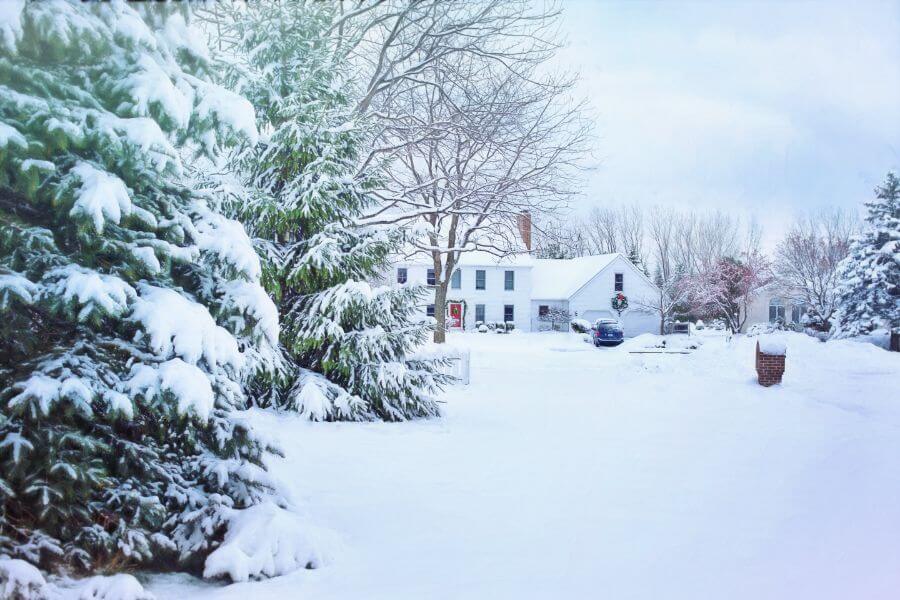
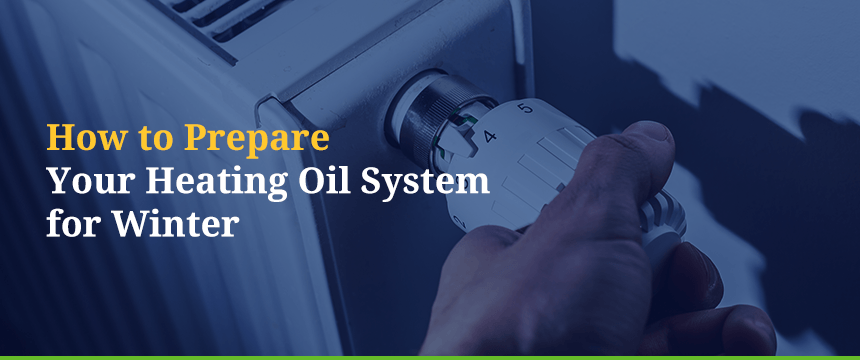
There’s a lot to love about fall in the northeastern United States, but there’s more to the season than beautiful leaves, apple cider, and warm coffee. Fall is also an important time to prepare your home for the winter ahead. If you’re one of the 20% of households in the Northeast that rely on heating oil to stay warm during the winter, then there’s no time like the present to get your home heating oil furnace ready for winter.
The worst thing that can happen in the wintertime is for your oil tank to run dry or your furnace to stop working. To prevent either of these situations from happening, add oil tank winterization and furnace maintenance to your fall to-do list. It just might save you money — and keep you warm — all winter long.
Here are some steps to take to prepare your heating oil system for winter.
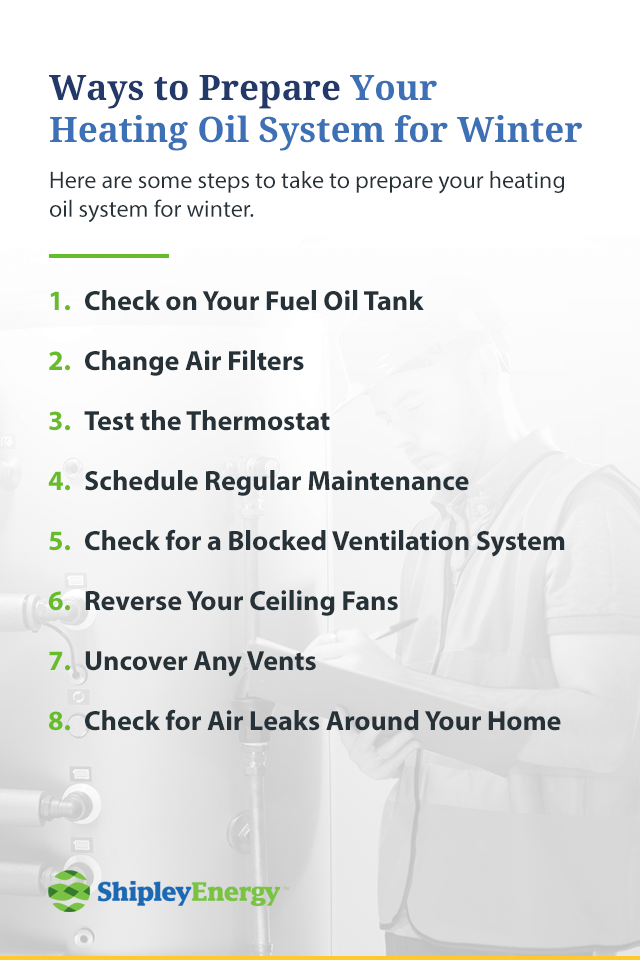
When you are getting ready to winterize your oil tank, start with the outside. Look for signs of rust, cracks, or other damage to the tank — any of these can signal a potentially bigger problem inside the tank, particularly if there is evidence of rust. If rust builds up inside an oil tank, it can mix with the fuel oil and clog the filter and other parts of the furnace, potentially costing you a lot of money in repairs. If you notice any signs that the integrity of your oil tank is compromised, call your fuel oil company to schedule repairs.
Another oil tank winterization tip is to stay on top of regular fuel oil deliveries. If your oil tank accidentally runs out, you’ll be without heat and risk damaging the tank and your furnace inside. Make a point of knowing how much oil you have and plan regular deliveries throughout the winter. If you’re enrolled in an automatic delivery program, your fuel oil delivery is scheduled as part of a regular rotation, so there’s nothing you need to do about how much is in there. But if you schedule delivery on an as-needed basis, then pay close attention to the tank’s oil level. If the oil level is at or below 1/4 full, then it’s time to schedule a delivery.
If you don’t already have one, consider purchasing a tank monitor to help you keep tabs on your fuel oil levels throughout the winter. Today’s digital monitors sync with your smartphone or tablet, allowing you to keep tabs on the oil levels inside your tank and alerting you when it’s time for a refill. Purchasing a monitor is one of the best ways to prepare your heating oil tank for winter because it will help ensure you won’t run out of fuel on the coldest days of the year.
A full fuel oil tank is only as good as the heating system inside. In most homes, the air conditioner and heating system share the same duct system, which means they’re blowing air through the same filter. After an entire summer of running your AC, your air filters will likely be dirty, so swap them out for fresh ones.
As a general rule of thumb, air filters that are in use year-round should be changed every 2 to 3 months, so you’ll likely need to change them again mid-winter. Be sure to stock up so that you have extras on hand and can easily change them when needed.
There’s nothing worse than turning on your heat for the first time in the middle of the night and discovering that nothing happens. Turn on the thermostat to make sure the heat kicks on at the right temperature — and continues to run until it reaches the temperature it’s set for. If the furnace doesn’t turn on or it can’t reach the set temperature on the thermostat, it’s time to call an experienced HVAC repair technician to diagnose the problem.
If you’re looking for ways to conserve fuel oil, it might be a good time to install a programmable thermostat. These thermostats allow you to schedule temperature changes in your home that correspond with your daily routine. For example, you can set the thermostat to go up during the afternoon and evening when you’re home and awake. Then, have the temperature go back down once everyone leaves for work or school the next morning. You can also keep the temperature lower at night when you’re asleep and relying on blankets to keep you warmer. Besides helping you conserve fuel oil — and money — a programmable thermostat can help to reduce wear and tear on the furnace, too. Reducing furnace wear and tear also helps to prevent equipment failure and can extend the life of your furnace.
Even if it appears that your furnace is operating, it’s a good idea to schedule a cleaning and maintenance appointment before the cold sets in. When you schedule regular maintenance with a reputable HVAC repair company, they send a reliable technician to inspect and clean the various components of your furnace. While they are cleaning, they can check for potential problems with parts of your system.
Regular maintenance can detect small issues before they become big — and expensive — problems. It can also extend the life of your furnace, ensuring it will continue to effectively heat your home for years to come.
Next, inspect your heating ventilation system for potential blockages. Some systems vent from the inside to outside through a piece of PVC pipe. Others vent through the chimney. Identify the location of your system’s ventilation and check for blockages. This is especially important if your furnace vents through a chimney because bird nests, soot, and other yard debris can become lodged inside — and a blocked vent can lead to carbon monoxide poisoning, which can be deadly.
Now is also a good time to test your home’s carbon monoxide detectors. Since carbon monoxide is odorless and colorless, it can quickly become deadly. While you’re testing the carbon monoxide detectors, replace the batteries as well to ensure the detectors work properly all winter long.
If you have ceiling fans in your home, fall is the time to reverse the direction the blades travel when the fan is running. Since warm air rises and cooler air stays closer to the floor, the heat that is generated from your furnace will naturally try to make its way up toward the ceiling. Reversing the direction of the fan’s blades creates an updraft, which pulls cold air toward the ceiling and keeps the warm air more evenly distributed in the room. This makes the room feel warmer and maximizes the heat already being produced without having to place additional demands on your furnace.
Sometimes, a fan’s reverse setting switch may be built into the wall panel, and all you have to do is flip the reverse switch. If you don’t have this, then turn the fan off, safely climb up and look for a little switch around the motor — the part set into the ceiling — and flip it. Climb down, turn the fan back on, and watch to confirm that the blades are now moving clockwise.
If your heating vents are in the floor or around the lower part of your walls, you may have inadvertently allowed them to get covered by furniture or other household items when they weren’t in use. Go around the house and make sure all of your heating vents are uncovered so that the warm air coming out of them isn’t blocked and can easily flow into the room and heat it.
The last thing to do to ensure your heating system can function properly throughout the winter is check for places in your home where cold air can sneak in. Often, these places can be found around doors and windows, so take some extra time to look for gaps and cracks around these parts of your home. If you find cracks that may let cold air sneak in and mess with the temperature of your home, use materials like weatherstripping and caulking to repair cracks and block the unwanted cold from coming inside.
The last thing you want is for the snow to be coming down outside and the furnace to stop working. Taking care of your heating system is essential to ensuring your family has a comfortable, warm home all winter long. Performing preventative maintenance on your heating system may not be a glamorous job, but the benefits of heating oil system maintenance are significant.
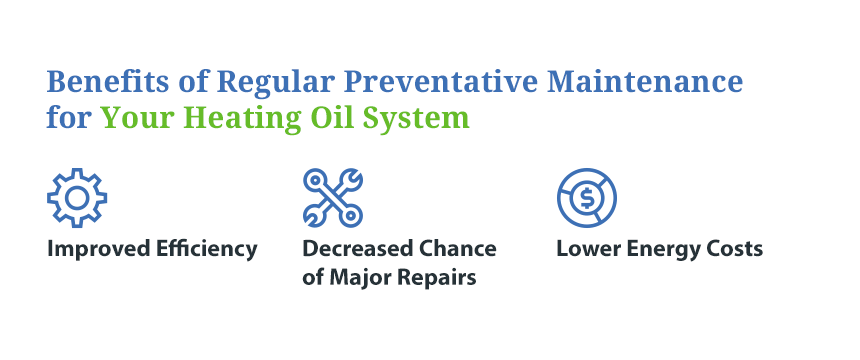
When you make regular heating system maintenance a priority, you improve your system’s overall efficiency. Keeping the system clean and addressing small problems early on prevents bigger problems later. In addition to checking the parts of your system yourself, it’s important to schedule regular maintenance and cleaning of your system to extend its life and also keep it working at optimum capacity, even on the coldest days of the year.
Regular maintenance can prevent a big break in your system — and save you from the cost of an emergency repair. A clean system operates more efficiently and doesn’t put as much strain on all of the furnace’s components. When everything is working as it should, parts are less likely to break.
A clean system is an efficient system, and an efficient system doesn’t cost as much to run. A furnace that’s working correctly doesn’t use as much fuel oil, which means you won’t be filling your tank as often. Since a fuel oil furnace still has several components that run off of electricity, your electric bills are likely to be lower as well.
Besides lower energy costs, you’ll also find that by keeping your home warm all winter, you can prevent pipes from freezing and potentially bursting. You can help prevent the unwanted growth of mildew or mold as well.
Whether your furnace is brand new or facing its twilight years, it’s important to follow these steps to prepare your heating oil system for winter. Perhaps the most important of all those steps is to make regular cleaning and maintenance a priority. At Shipley Energy, our comprehensive residential furnace services include inspections, tune-ups, and cleanings.
When you schedule a comprehensive inspection of your furnace, our NATE-certified technicians will inspect each of the system’s components, including:
If your furnace is newer, inspection and cleaning may be all that’s required. But if your furnace is older or our technicians spot a potential problem, they can quickly develop a plan and give you an estimate of what it will cost to repair the problem. Catching a problem early on may cost a little bit now, but it can save you a lot of money down the road.
If your furnace is nearing the end of its life, our technicians can provide you with advice on whether or not it’s time to replace your unit. In some cases, it may still be cost-effective to repair what you have. In other instances, though, it may save you more money over time to replace your furnace with a newer model.
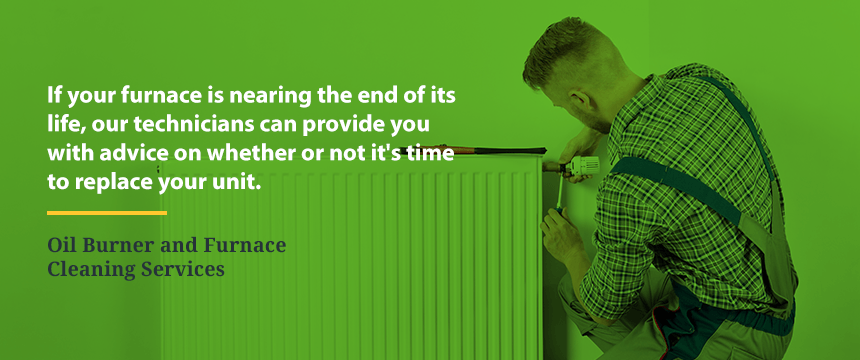
Signs that your furnace needs to be replaced include:
If you’ve experienced any or all of these signs that your furnace isn’t efficiently providing heat, then it might be time to replace your unit with a newer, more efficient model.
When it comes to preparing your heating system for winter, regular maintenance can go a long way toward keeping your furnace working and your family warm. At Shipley Energy, we are committed to helping our customers maintain a safe and warm home even in the coldest winter months. Serving select areas in Pennsylvania and Maryland for 90 years, we’re also committed to providing quality products and outstanding customer service.
If you have questions about how to winterize your oil tank or need to schedule an inspection or repair for your system, call our experienced team of professionals at 855-275-9720. You can also contact us online to learn more about our residential heating oil services or check out our rates.
